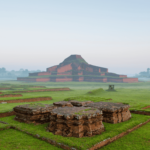Introduction
Bangladesh is often celebrated for its vibrant culture and diverse traditions, but one aspect that stands out is its rich tapestry of religious architecture, particularly Hindu mandirs. Did you know that there are over 1,000 Hindu temples in Bangladesh, each with its own unique story? These mandirs are not just places of worship; they are vital cultural heritage sites that reflect the country’s rich history and architectural brilliance. In this article, we’ll delve into some of the most significant Hindu mandirs in Bangladesh, their historical context, and what makes them so special!
Historical Significance of Hindu Mandirs in Bangladesh
The history of Hindu mandirs in Bangladesh dates back centuries, weaving through the vibrant tapestry of the region’s past. Hinduism has been practiced here since ancient times, with roots that trace back to the early settlements along the Ganges and Brahmaputra rivers.
Over the centuries, various dynasties, including the Pala, Sen, and Mughal, have left their mark on temple architecture and culture. The Pala dynasty, for example, played a crucial role in the development of a distinctive style characterized by intricate carvings and sculptures. These mandirs not only served as places of worship but also as centers for education, arts, and community gatherings.
In the context of Bangladesh, these temples reflect the resilience of the Hindu community throughout history, especially during periods of political and social upheaval. Understanding this historical significance is essential, as it illuminates the enduring legacy of Hindu culture in Bangladesh.
Architectural Styles of Bangladesh Hindu Mandirs
Bangladesh is home to a fascinating array of architectural styles in its Hindu mandirs, each with unique elements and influences. The Kalinga style, for example, is known for its elaborate carvings and pyramid-like structures, whereas the Dravidian style features towering gopurams (entrance towers) that reach skyward.
The architectural beauty of these temples lies in their details. Take the Kantaji Temple, renowned for its exquisite terracotta tiles that depict scenes from Hindu mythology. Visitors can spend hours admiring the craftsmanship that has stood the test of time.
In addition to traditional styles, some modern mandirs incorporate contemporary elements, creating a fusion that respects heritage while embracing innovation. This blend of old and new is an exciting aspect of the evolving landscape of Hindu architecture in Bangladesh.
Prominent Hindu Mandirs in Bangladesh
Among the myriad temples scattered across the country, certain mandirs stand out for their historical and cultural significance. The Dhakeshwari Temple, located in Dhaka, is considered the national temple of Bangladesh. Established in the 12th century, it is a pilgrimage site for Hindus and has witnessed countless festivals and rituals.
The Kantaji Temple in Dinajpur is another remarkable site. Built in the 18th century, it is famous for its intricate terracotta work and is a prime example of the Bengali architectural style. These temples are not just architectural marvels; they serve as vibrant centers for cultural and religious activities, where community members gather to celebrate festivals like Durga Puja and Janmashtami.
Each mandir tells a story, and visiting them offers insights into the spiritual practices, festivals, and communal life of the Hindu community in Bangladesh.
The Role of Hindu Mandirs in Contemporary Society
In contemporary society, Hindu mandirs play a multifaceted role beyond being mere places of worship. They act as community hubs where people gather for festivals, ceremonies, and social events. The warmth and camaraderie felt during celebrations like Maha Shivaratri or Durga Puja are truly heartwarming.
Moreover, these mandirs often engage in charitable activities, supporting the needy and fostering a sense of community. They host educational programs, cultural workshops, and interfaith dialogues, promoting understanding and cooperation among diverse religious groups. This role of mandirs as community centers is essential for preserving the cultural fabric of Bangladesh.
As interfaith relations continue to evolve, mandirs also become spaces for dialogue and reconciliation, encouraging unity in diversity. It’s heartening to see how these sacred places adapt to the changing times while preserving their core values.
Visiting Tips for Exploring Hindu Mandirs in Bangladesh
If you plan to explore the stunning Hindu mandirs of Bangladesh, there are a few tips to keep in mind to ensure a respectful and enriching experience. First and foremost, familiarize yourself with the customs and practices of the mandirs you visit. For instance, it’s customary to remove your shoes before entering the temple premises.
Dress modestly, as a sign of respect for the sacred environment. Women should consider wearing a sari or long dress, while men can opt for trousers and shirts. Be mindful of photography rules; some mandirs may not allow photography inside sacred spaces.
Timing your visit can enhance your experience. Festivals are bustling and vibrant times to visit, offering a chance to witness grand celebrations. However, quieter periods allow for reflection and appreciation of the temple’s beauty.
Finally, engage with locals and temple officials; they often have fascinating stories and insights to share about the history and significance of the mandir.
Conclusion
In conclusion, exploring the Hindu mandirs of Bangladesh is a journey through time, culture, and spirituality. These temples are more than just architectural wonders; they embody the resilience, artistry, and deep-rooted traditions of the Hindu community. As we visit and appreciate these sacred spaces, we recognize the stories they tell and the heritage they protect.
I encourage you to seek out these mandirs in your travels, immerse yourself in their history, and respect the rituals that take place within their walls. Whether you’re a local or a traveler, each visit offers a unique opportunity to connect with the rich culture and spirituality of Bangladesh. Have you visited a Hindu mandir in Bangladesh? Share your experiences or tips in the comments below!







